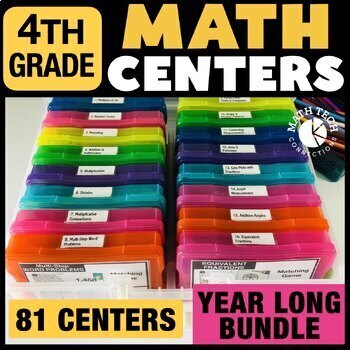4th Grade Math Centers Task Cards Bundle | Games | Math Spiral Review Activities
- Zip
What educators are saying
Products in this Bundle (27)
showing 1-5 of 27 products
Bonus
Also included in
- This 4th grade math bundle includes three activities per math topic that can be used during centers, math warm ups, math exit tickets, or math homework. This 4th grade math practice bundle includes both PRINT and DIGITAL format. - The printable format includes 81 activities - The paperless format inPrice $49.00Original Price $108.00Save $59.00
Description
These Fourth Grade math games will save you time and help students stay focused and organized during math centers.
This resource includes 27 game sets. This bundle includes a total of 81 math games, so you will have math centers for the entire year!
CLICK HERE TO DOWNLOAD ONE FREE SET!
★ Each game set includes the following: ★
- 3 Math Games: Math Sort, Matching Game, Clip Cards
- Recording Sheet
- Answer Key
Bonus File:
- Covers & Labels
- Common Core, TEKS and Florida Best Standards
- Lesson Plan Template
★ Included in This Complete Bundle ★
1 - Multiples of 10
2 - Number Forms
3 - Rounding
5 - Multiplication
6 - Division
7 - Multiplicative Comparisons
9 - Prime & Composite Numbers, Create Factor Pairs
12 - Area & Perimeter
13 - Line Plots with Fractions
14 - Angle Measurement
15 - Additive Angles
16 - Equivalent Fractions
17 - Comparing Fractions
18 - Adding & Subtracting Fractions
20 - Fractions with Denominators 10 or 100
21 - Decimal Notation for Fractions
22 - Compare Decimals
23 - Lines & Angles
24 - Classifying Shapes & Symmetry
27 - Problem Solving with Numerical Data
★ The Problem with Guided Math ★
- One big problem with guided math is not knowing what to assign for math centers.
- It can get especially overwhelming when pulling math games from various places. Teachers end up wasting lots of time explaining directions and students get off task because they are confused.
- Another big problem is holding students accountable for their work during math centers. You want students to record their work, but then you don’t have extra time to check or organize all the recording sheets.
★ The Solution ★
✓ The math games are standards-aligned. This means you know students are practicing the skills you are required to teach. The learning goal is posted on each math game.
✓ There is a predictable routine. Each math center has 3 math games per math standard. (Math Sort, Matching Game, Clip Cards) The game structure is the same, so you won’t waste time teaching new games each week.
✓ Students use one recording sheet. Students stay organized by only needing one recording sheet per topic. An answer key is provided, so you or students can check their answers.
✓ These math games come with label cards that will help you organize the math centers. These label cards include pictures and directions for each game.
More 4th Grade Math Centers
- 4th Grade Digital Math Centers
1-6 MATH GAME BUNDLES






